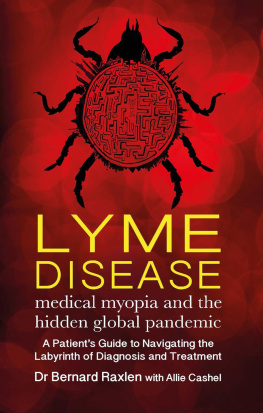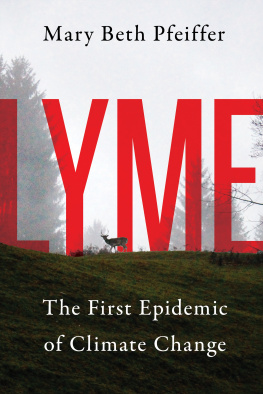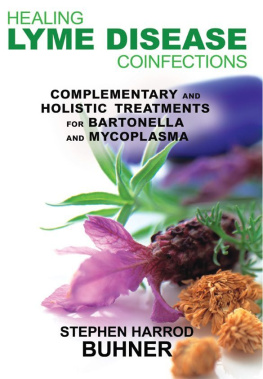Advance Praise for
Lyme Disease , second edition
An outstanding book on the history, diagnosis, treatment, preventive measures, and natural course of Lyme disease. Alan Barbours Lyme Disease is comprehensive and understandablean informative and much-needed book both for medical and scientific professionals and for the thousands of people annually exposed to tick bites.
JOHN F. ANDERSON, Distinguished Scientist, Emeritus, The Connecticut Agricultural Experiment Station
If you are seeking reliable and accurate evidence-based information on Lyme disease, this is the first book to read. It is a welcome relief from the cacophony of false and misleading information being disseminated in the media, and thereby makes a significant contribution to public health. It will be a valuable reference resource on Lyme disease for many years to come.
PHILLIP J. BAKER, Executive Director, American Lyme Disease Foundation
Science is complexinfections and the immune response to them particularly soand complexity sows confusion. Misinterpretations of the biology of Lyme disease have created an air of mystery, making it possible for fanciful notions to grow up around this great imitator. In this charming volume, Dr. Barbour, a pioneer of this field, provides a remarkably clear yet subtle description of these complexities, readable by any nonscientist who truly wants to understand this fascinating infection. A must read!
JOHN J. HALPERIN, Atlantic Neuroscience Institute, Overlook Medical Center and Icahn School of Medicine at Mount Sinai
Want to really understand Lyme disease? Here is an engaging, conversational review that is presented with empathy. It is clear, thorough, nuanced, and evidence based. Grounded in the principles of good medicine, this book will be a valuable resource for health care providers and patients alike.
BARBARA J. B. JOHNSON, retired from the Centers for Disease Control and Prevention
Alan Barbour has been at the forefront of Lyme disease research for over 40 years. His book is an invaluable resource for everyone concerned about the disease.
SUSAN OCONNELL, former head of the Lyme Borreliosis Unit, Health Protection Agency Microbiology Laboratory, Southampton University Hospitals Trust, United Kingdom
A Johns Hopkins Press Health Book
LYME DISEASE
LYME DISEASE
Why Its Spreading,
How It Makes You Sick,
and What to Do about It
ALAN G. BARBOUR, MD
JOHNS HOPKINS UNIVERSITY PRESS
Baltimore
Note to the reader. This book is not meant to substitute for medical care of people with Lyme disease or another infection transmitted by deer ticks, and treatment should not be based solely on its contents. Instead, treatment must be developed in a dialogue between the individual and his or her physician. Our book has been written to help with that dialogue.
Drug dosage : The author and publisher have made reasonable efforts to determine that the selection of drugs discussed in this text conform to the practices of the general medical community. The medications described do not necessarily have specific approval by the U.S. Food and Drug Administration for use in the diseases for which they are recommended. In view of ongoing research, changes in governmental regulation, and the constant flow of information relating to drug therapy and drug reactions, the reader is urged to check the package insert of each drug for any change in indications and dosage and for warnings and precautions. This is particularly important when the recommended agent is a new and/or infrequently used drug.
1996, 2015 Johns Hopkins University Press
All rights reserved. Published 2015. First edition published as Lyme Disease: The Cause, the Cure, the Controversy , 1996.
Printed in the United States of America on acid-free paper
9 8 7 6 5 4 3 2 1
Johns Hopkins University Press
2715 North Charles Street
Baltimore, Maryland 21218-4363
www.press.jhu.edu
Library of Congress Cataloging-in-Publication Data
Barbour, Alan G., 1946
Lyme disease : why its spreading, how it makes you sick, and what to do about it / Alan G. Barbour, MD.
pages cm. (A Johns Hopkins press health book)
Includes bibliographical references and index.
ISBN 978-1-4214-1720-2 (hardcover : alk. paper)ISBN 978-1-4214-1721-9 (pbk. : alk. paper)ISBN 978-1-4214-1722-6 (electronic)ISBN 1-4214-1720-0 (hardcover : alk. paper)ISBN 1-4214-1721-9 (pbk. : alk. paper)ISBN 1-4214-1722-7 (electronic) 1. Lyme diseasePopular works. I. Title.
RC155.5.B38 2015
616.9'246dc23 2014036888
A catalog record for this book is available from the British Library.
Special discounts are available for bulk purchases of this book. For more information, please contact Special Sales at 410-516-6936 or specialsales@press.jhu.edu.
Johns Hopkins University Press uses environmentally friendly book materials, including recycled text paper that is composed of at least 30 percent post-consumer waste, whenever possible.
Contents
Preface
Some readers may be wondering whether this is a new edition of my 1996 book or a new book. A more pressing question might be why a new book or a new edition now? One reason is that large portions of the original book are admittedly out of date (only about 10 percent of the first books text was retained in this edition). In the interval since 1996, Lyme disease has continued to rise in frequency and to spread its reach in North America, Europe, and Asia. A human vaccine has come and gone from the market. There are new diagnostic tests, greater appreciation of the long-term consequences of the infection for some patients, and better understanding of what could be effective measures to control Lyme disease. A second reason is the increasing public health importance of other infections transmitted by the same ticks that carry the Lyme disease microbe. These include a protozoan related to the cause of malaria, a deadly virus of the brain, and other types of pathogenic bacteria, one of which was only recognized as a cause of human disease in the last year. These other diseases merit increased attention.
The title Lyme Disease is the same, but the new subtitle diverges from The Cause, the Cure, the Controversy . While acknowledging the continuing divide on what the definition of Lyme disease should be and how the disease should be diagnosed and treated, I concluded that to do justice to each point of controversy, with presentations of all sides, would consume most of the books allotted pages. I touch upon the controversy as needed and provide readers with sources that seem to be fairly representative of, if not the latest word on, the different positions. But the viewpoint of this book is essentially as I described for the first book: in cases where there are controversies, I give the opinion or recommendation that is best supported by the available scientific (i.e., evidence-based) data. As the 1996 book preface stated: Some unproven theories and ideas are very appealing, but they are difficult to recommend if the only basis for their acceptance at this point is anecdotal. Compelling stories, many of them from patients, should be taken seriously: they may point the direction to new concepts of disease and treatment. But ultimately those holding views that are contrary to what has been shown scientifically must put their own theories to the test.
In the interval since the first book, my studies of Lyme disease, the bacteria that causes it and other diseases, the wildlife that carry them, and the ticks that transmit them have been supported by grants from the National Institute of Allergy and Infectious Diseases of the National Institutes of Health, the Centers for Disease Control and Prevention, the National Research Fund for Tick-Borne Diseases, and the Ellison Medical Foundations Senior Scholar Award in Global Infectious Diseases. The research has also been partially supported by royalties from licensing of patents for a vaccine against Lyme disease for humans and dogs and for a component of a diagnostic assay for Lyme disease in humans and dogs. At pertinent places in the book, I disclose when consideration of a vaccine or a diagnostic assay might be a conflict of interest on those grounds.
Next page





